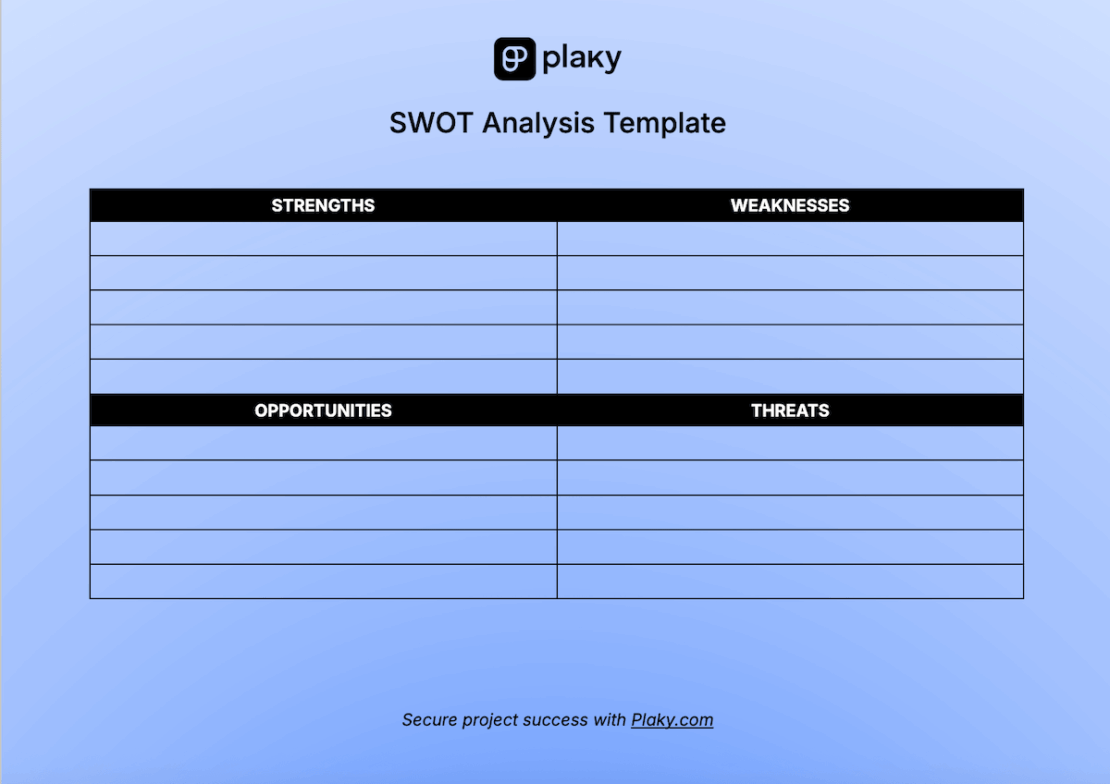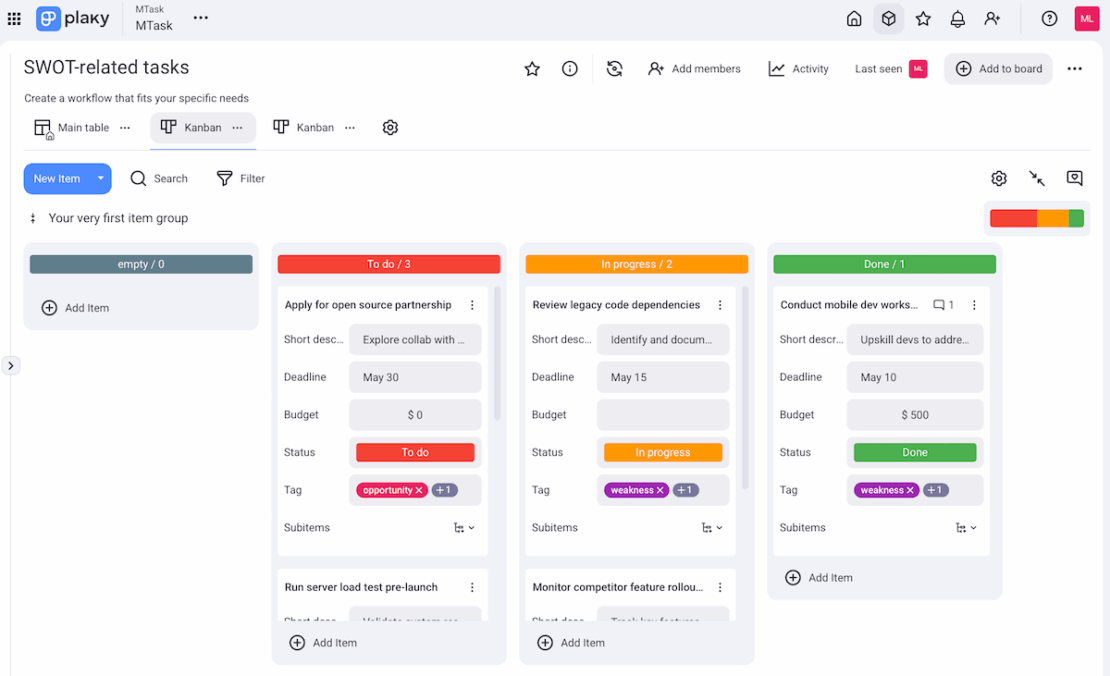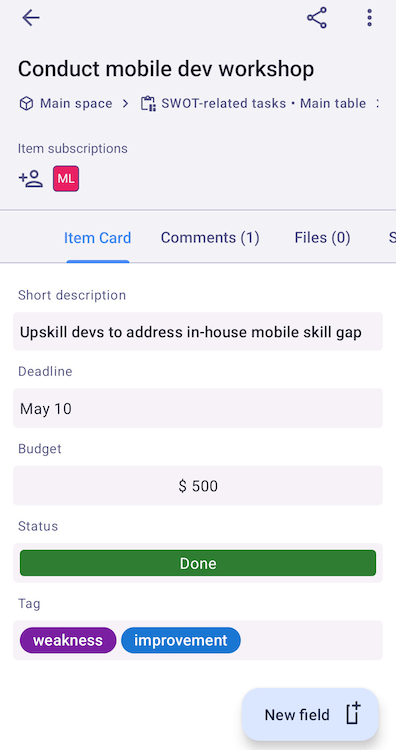A well-timed SWOT analysis can give your project a powerful edge. This is more than just a brainstorming exercise — it can actually help you strengthen project outcomes, spot risks early, and uncover hidden opportunities.
Today, we break down exactly how to identify your project’s strengths, weaknesses, opportunities, and threats.
Bonus: You get a free customizable template to make the process even simpler.
And, of course, SWOT is only the beginning since the real results come when you turn insights into trackable action. So, we’ll also show you how to use a PM tool to maximize the impact of your SWOT analysis.
Let’s dive right in!

In this article:
What is a SWOT analysis in project management?
The SWOT analysis (or SWOT matrix) is a strategic planning tool commonly used in project management to evaluate the following 4 aspects of a project:
- Strengths — internal advantages of your project,
- Weaknesses — internal factors hindering progress,
- Opportunities — external factors you can use to your advantage, and
- Threats — external risks that could jeopardize your project’s success.
Ideally, this analysis is done at the start of a project — as early as the planning stage — but it’s also useful during key milestones or major changes.
More importantly, SWOT doesn’t require advanced training, so even professionals without much project management experience can use it effectively.
It’s a relatively low-effort activity with notable strategic payoff, especially if done collaboratively with the project team and stakeholders.

Benefits of using a SWOT analysis in project management
The SWOT analysis may seem rather simple, but don’t underestimate its power. Here are its key benefits:
- Flexible & scalable tool — SWOT works for projects of any size or complexity. You can adapt it to high-level portfolio planning or apply it to specific project phases or decisions.
- Adaptable format — The analysis can be done in a workshop, over a team meeting, or even asynchronously using a shared document. This is perfect for virtual project management, which is definitely on the rise.
- Enhanced decision-making — By mapping out external and internal factors, you fully understand your project environment and can make informed decisions.
- Early risk identification — Threats and weaknesses often translate into project risks. A SWOT analysis helps you identify them early, employ suitable mitigation strategies, and avoid project failure.
- Highlighted opportunities — Sometimes, we’re so focused on problems that we overlook promising opportunities. A SWOT analysis forces you to look at what’s working in your favor (e.g., new technologies and organizational changes).
- Team alignment — Involving your team and stakeholders in the analysis ensures they’re aligned around project goals, leading to better collaboration and communication in project management.
Get a powerful PM tool — Plaky
How to use SWOT analysis in project management
Here’s how to approach each part of the SWOT chart to take a structured look at your project.
Strengths
Start by specifying the project’s internal assets and enablers. They serve as an advantage over competitors and increase the chances of creating a winning project strategy.
You can identify what sets you up for success by posing these questions:
- What expertise or project management skills does the team already have?
- Are there well-established tools or frameworks in place?
- Is the project scope clear, with aligned goals and resources?
- Are there past successes or reusable assets you can leverage?
Remember, these are your project’s strong points, so you’ll want to reinforce them and build your project timeline and strategy around them where possible.
Weaknesses
It’s important to be realistic about internal limitations and vulnerabilities that could impact the quality, timeline, and outcomes of your project. Consider the following:
- Are there gaps in skills, tools, or capacity?
- Is the project scope unclear or frequently shifting?
- Are project roles and responsibilities well defined?
- Are any of your internal processes slow or overly complex?
Being brutally honest when recognizing weak spots gives you a chance to address them promptly or build buffers into the plan.
💡 Plaky Pro Tip
If unclear or shifting requirements are a recurring issue, consider them a major weakness. You can improve this by choosing the right requirements gathering technique — read all about it here:
Opportunities
Certain external trends or situations could elevate your project’s value or even turn into long-term gains. To find them, explore these questions:
- Are there new technologies or tools you can adopt?
- Is there a shift in market trends or organizational goals that match your project?
- Are there external partnerships, stakeholder interest, or funding you can tap into?
In other words, you should stay vigilant and flexible — if you spot an opportunity early, you can tailor your approach to maximize its impact.
Go for a reliable tool — try Plaky!
Threats
All projects face factors outside your control that could disrupt or derail the project if not handled properly. The main questions here are the following:
- Are there regulatory or compliance changes looming?
- Could external vendors or tools become unavailable?
- Are project stakeholders likely to shift priorities or budgeting methods?
- Are competitors or market conditions pressuring delivery dates or user expectations?
While threats can’t always be avoided, they can at least be anticipated, which allows you to apply effective project risk management.
💡 Plaky Pro Tip
Want to enrich your PM knowledge and build an even better foundation for successful projects? Take a look at this guide:
Free SWOT analysis template

Download: Google Docs | Microsoft Word | Google Sheets | Microsoft Excel | PDF
To help you get started, we created this free and customizable SWOT analysis template in several formats. Go for whatever suits you best — you can even print it out using the PDF version.
Essentially, this template is a simple table divided into the 4 key categories, allowing you to easily organize your insights.
Whether you’re planning a new project, reviewing progress, or preparing for a stakeholder presentation, the template serves as a structured space to capture what matters. Plus, it’s easy to edit and perfect for both team workshops and solo planning.
Track project success with Plaky
An example of a SWOT analysis
To show you how the SWOT analysis works in practice, let’s look at an example — a team developing a custom mobile app for a retail client.

This analysis gives project managers a clear overview of the project’s internal capabilities and external conditions.
For example, while the team’s technical strengths and Agile process are key assets, the lack of QA resources is a serious concern that calls for careful planning.
On the external side, the opportunity for long-term collaboration is promising, but looming threats like API delays and a competing app highlight why risk mitigation is crucial.
Overall, this kind of analysis prepares the team to respond proactively and build an effective strategic marketing plan.
💡 Plaky Pro Tip
Check out some other useful PM templates below:
Disadvantages of using a SWOT analysis
While SWOT is a useful and widely used tool, it’s not without limitations. To avoid relying on it too heavily or in the wrong context, consider these drawbacks:
- Subjectivity & bias — Since SWOT relies on human input, the results can be influenced by assumptions, personal opinions, or incomplete information.
- No prioritization — The analysis asks you to list items under each category, but not to rank them, which can dilute focus and lead to confusion rather than clarity. That’s why we recommend using project prioritization methods along with SWOT.
- Not accounting for interdependencies — SWOT tends to treat each factor in isolation, and sometimes items in it interact in complex ways that this analysis doesn’t fully capture.
Tips for conducting a SWOT analysis
Doing a SWOT analysis is more than just filling out those 4 boxes — it’s about gaining meaningful insight to guide you toward the project goal.
Whether you’re running a quick brainstorming session or a formal planning workshop, these practical tips will help you get the most value from the process:
- Be as specific as possible — Avoid general statements like “We’re motivated and productive”; instead, state information such as “The team has successfully delivered 3 similar projects in the past year.”
- Use data where possible — Support your points with real evidence (survey results, risk logs, customer feedback, etc.) to add credibility to your analysis.
- Turn insights into action — Use SWOT to improve plans (adjust timelines, spot risks, or seize new opportunities) since the findings can directly impact execution.
- Assign tasks — Delegate tasks and responsibilities to the right people (i.e., team members with the most expertise in those areas) to improve accuracy.
- Revisit your SWOT regularly — Review and update your analysis at major milestones or when conditions change, as this shouldn’t be a one-time exercise.

Implement your SWOT results effectively with Plaky
Once your SWOT analysis is complete, the real work begins. You must put those insights into motion!
This is where our project management platform, Plaky, truly shines. It’s great PM software for small teams and big organizations alike, helping you connect strategy and execution.
To begin with, the spaces-boards-items hierarchy in Plaky keeps things clean and navigable. For example, you can create a board with SWOT-related tasks (items) within your team’s workspace and arrange them however you like.

You can describe each item in Plaky through versatile custom fields that allow you to state task details, boosting clarity and accountability:
- (Rich) text — add descriptions, task notes, or checklists,
- Number — specify budgets, risk scores, story points, and so on,
- Person — add assignees and reviewers,
- Date — set clear deadlines,
- Link — link relevant documents, design files, research, etc.,
- Status — track progress visually (e.g., To do, Ongoing, Done), and more.
Another perk in Plaky is having multiple board views. You can visualize the execution of your SWOT analysis and other assignments in a way that suits your team’s workflow:
- Table view — for a quick data entry and spreadsheet-like overview,
- Kanban view — for a visual representation of tasks moving through stages, and
- Gantt chart view — for a high-level overview of project schedules.

To ensure nothing slips through the cracks, Plaky maintains an activity log — a chronological record of all changes made on the platform. Moreover, you can add comments within each item card to quickly share updates, centralize discussions with colleagues, and avoid endless email threads.
Another element that boosts security is setting different user roles and permissions in Plaky. You can control who can update or edit tasks, while still giving visibility to stakeholders who need to stay informed without being involved in day-to-day execution.
And, since teams are often in meetings, on-site, or hybrid, mobile data access is a must too. That’s why Plaky offers mobile apps (Android and iOS), letting you review, discuss, and update tasks from anywhere!

Have your projects at your fingertips with Plaky’s mobile app
Ready to turn your SWOT insights into project wins? Create a free Plaky account right now!
